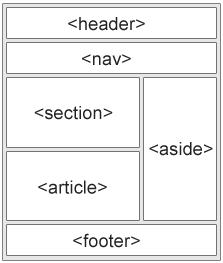General Structure/Layout
(Not fully used on the code for this page)

header - Defines a header for a document or a section
nav - Defines a set of navigation links
section - Defines a section in a document
article - Defines an independent, self-contained content
aside - Defines content aside from the content (like a sidebar)
footer - Defines a footer for a document or a section
details - Defines additional details that the user can open and close on demand
summary - Defines a heading for the <details> element
You can read more about semantic elements in our
HTML Semantics chapter
